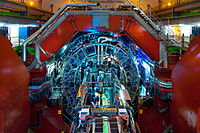
Photo from wikipedia
High energy collisions are the laboratories within our reach to study the strongly interacting matter under extreme temperatures. In the present study, we use a quarkonia suppression scheme to explain… Click to show full abstract
High energy collisions are the laboratories within our reach to study the strongly interacting matter under extreme temperatures. In the present study, we use a quarkonia suppression scheme to explain the bottomonium production at the two LHC energies. We employ ECHO-QGP to model the (3 + 1)dimensional relativistic viscous hydrodynamic evolution of the medium. Bottomonia produced in the early stage dissociates due to color screening, gluonic dissociation, and collisional damping in addition to the shadowing as an initial state effect. In the color screening mechanism, the temperature from hydrodynamics is used to find the screening radii at each centrality and rapidity. Shadowing effect utilizes the parton distribution functions obtained from CT14 global analysis and shadowing factors from EPPS16. A Lattice QCD based equation of state from Wuppertal-Budapest collaboration has been used. The experimental values of poins(π+) spectra were used to constrain the initial conditions of the dynamics. The bottomonium suppression is determined as a function of centrality, transverse momentum and rapidity for Υ(1S) and Υ(2S) at the LHC energies of 2.76 TeV and 5.02 TeV. We find a fairly good agreement between our theoretically calculated survival probability and the measured nuclear modification factor(RAA) at the two energies.
Journal Title: Physical Review C
Year Published: 2021
Link to full text (if available)
Share on Social Media: Sign Up to like & get
recommendations!